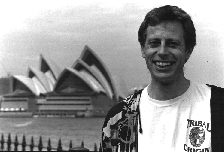US Libraries and Fiction Preview
Angels Can Fly has begun to break into the American library market, with the first ten copies now in US Public Libraries. Check out your library to see if they have a copy, and if they don't, tell them they can get a copy from the US wholesale distributor, Ingram Library Supplies.
"Clown is a fascinating, diverse, complex and exciting art form, which has existed around the planet for thousands of years. Like any art form it has to evolve to stay relevant to the culture nurturing it, and at the same time, and by its very nature, clown teases and turns upside down the cultural patterns and boundaries around us."
This month we continue a series of excerpts from the book, with a preview of part of the fictional section from chapter one:
Easy's Pride and Joy
Easy arrived down at the street-theatre pitch early, his four year old son, Jasper, running at his heels. Sugar had already started a show however, so he took off his back-pack and sat down on the grass, to consider the options.
Jasper sat in his lap, his eyes on the show.
Sugar had a large crowd and, from where they were sitting, Easy and Jasper were just getting glimpses of her through gaps in the audience. Then a large group walked away, right in front of them, and they got a window into the show.
Sugar wiped the back of her hand across her mouth in a vulgar way, adjusted her trademark bustle which enlarged her backside, then smiled warmly at a man who stood in front of her in the audience.
"Hi, what's your name?" she asked him.
He made no reaction, fearful of where any response might lead, and immobilised by the attention of the crowd.
"The questions get harder," she teased him.
Easy saw the realisation dawn on him that it was easier to play along, than to resist.
"Mike," he admitted.
"Right answer!" she encouraged him.
He grinned.
"Now I want you to do exactly as I do," she told him.
"Okay Mike?"
He nodded. Even a nod was a daring move, and she turned to face the same direction as him, and imitated his reluctant stance, and the audience laughed.
Then she took a step forward, and waited in anticipation that he should do the same. After a moment, lush with humour from his indecision, he followed her lead, which brought him out of the crowd and onto the stage.
"She's good today," Jasper said.
Easy nodded, and cuddled the boy.
Sugar led Mike step by step, until they reached the centre of the circle, and with every step his reluctance was confronted and released. And a broad smile broke out on his face as she teased the courage from him.
Easy could see that she was going to do a long show, which was slowly gathering a bigger and bigger crowd.
"We'll have to go to the park and try a show," he told Jasper.
"Daddy, I want to watch her show," Jasper said.
"I've got to make some money."
"Do one here afterwards."
Easy looked over to the back of the pitch, where he could see Ginger was already waiting to go next. This meant he would be second in line, which would probably still be okay, he thought, and anyway he wanted to catch up with Ginger.
"Okay, you go and watch the show then," he told Jasper, "and I'll be at the back, with the others, okay?"
Jasper nodded, and scampered happily off, pushing through to the front of Sugar's crowd, to sit down on the pavement.
Easy took his gear over to the back of the pitch, and Ginger smiled as he approached.
"Hi," he greeted her.
They kissed one another on the cheek. Her green hair gave her an alien sort of feel, very beautiful in the sunlight, he thought...
Angels can Fly includes a mix of fiction which follows the adventures of ten clown characters, some personal clown anecdotes from clowns from around the world, a total of 50 practical clown exercises, and some theory on the nature of modern clown. The book is available on order through bookshops and online stores in Australia, America and England. Order your copy today. Find it on Amazon by following this link: http://tinyurl.com/9nrwj


